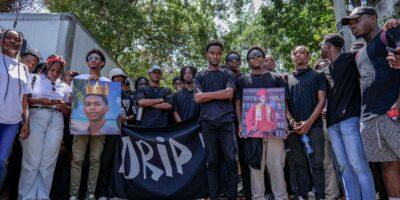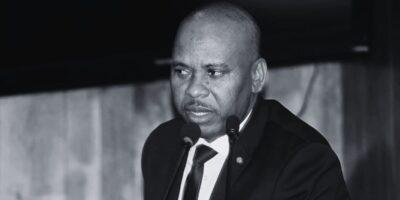« Serious engagement with Haitian history, beyond the Revolution and beyond the tired narratives of Haiti as a failed state, is paramount »
Last Friday, the news of Kanye West’s surprise visit to Haiti swept through social media. Images and videos released on different platforms detail the itinerary of the American rapper. From the tarmac of the Hugo Chavez airport in Cap-Haïtien, an impromptu encounter with tennis star Naomi Osaka at the salon diplomatique, to dancing with a folkloric troupe at Le Cormier Hotel after a boat ride with Haitian President Jovenel Moïse, the star’s schedule was busy. According to the Haitian Ministry of Tourism, West travelled to the Caribbean nation simply to visit a germplasm center, the popular cruise port of Labadee, and Tortuga Island. Yet, one of the videos circulating reveals a clue as to the real reason for the American rapper’s trip: “we’re building a city,” Kanye West tells Naomi Osaka.
Who is this “we” Kanye West refers to? Perhaps it includes Shervin Kordary Pishevar, a venture-capitalist featured in this year’s Forbes Midas List for “The World’ Best Venture Capital Investors,” who accompanied West on the trip to the Caribbean nation. Pishevar, whose success is rooted in his visionary investment in companies like Uber and Airbnb, as well as trendy companies like Postmates, Warby Parker, and the Virgin Hyperloop One, among others, is a notable philanthropist. Pishevar’s personal website claims that the capitalist man is “a devoted, influential philanthropist who donates money, time and leadership to numerous global and local charities.” However, it has been demonstrated that corporate philanthropy is simply a game of smoke and mirrors in which plutocrats yield and exert power through seemingly charitable endeavors while securing tax breaks.
A rape allegation made against Pishevar resulted in his arrest in London in May 2017. Later that year, five additional women came forward and accused him of sexual misconduct, and detailing how Pishevar “used his position of power to pursue romantic relationships and unwanted sexual encounters.” Following those accusations, Pishevar announced he would step down from his position at his firm Sherpa Capital.
In addition to Pishevar, it was reported that representatives from the Elon Musk-led companies SpaceX and Tesla were also present during the visit.
A tweet from the official account of President Jovenel Moise reads: “Kanye West’s visit is an opportunity for me to invite the African American community to become more involved in various investments in Haiti. Our country is the perfect place to promote universal culture. Haiti is Africa in the heart of America.”
This statement by the Haitian president is alarming. Haiti is not a proxy for Africa nor is it a promise land or the “new ‘El Dorado’” for foreign investors, African Americans like Kanye West included. Any engagement with Haiti must prioritize a shrewd understanding of both Haiti’s current political landscape and the country’s past.
Kanye West who tweeted that “Haiti is where our people started the first revolution that freed us from slavery” neglected to visit the Citadelle Laferrière, the awe-inspiring nineteenth-century fortress perched on Bonnet à l’Evêque, that stands as a material reminder of the sustained threat from foreign powers Haiti faced in the decades following independence as the country strived to fashion and maintain its Black sovereignty in a hostile trans-Atlantic world.
The Haitian Revolution cannot and should not be reduced to an empty symbol, nor should it be the sole historical marker that non-Haitians rely on to engage with the first Black Republic of the world. Serious engagement with Haitian history, beyond the Revolution and beyond the tired narratives of Haiti as a failed state, is paramount.
In another tweet, Kanye West—who has infamously stated that “slavery was a choice”— prophesizes: “WE ARE HERE TO COMPLETE THE REVOLUTION WE ARE ARE BUILDING THE FUTURE (sic).” This begs the question: of which revolution does West speak? Is it the one that will finally release the Haitian people from the neocolonial yoke of foreign powers? The irony is palpable: while tweeting about revolution, Kanye West was parading around with the same president who, following the failed 2019 legislative elections that resulted in the dissolution of the Haitian parliament, has been ruling by decree for nearly a year.
What future can be built when President Moise has yet to be held accountable for his direct and proven implication in the misuse of $1.7 billion of the PetroCaribe funds? No revolution can be achieved without the Haitian masses, the ones that are still coping with the social, political, economic, and psychological aftershocks of the 2010 earthquake; the ones that have expressed deep distrust of the president’s ability to undertake fair and democratic elections in the upcoming months; the ones that have and continue to decry the corruption of the current administration; the ones that have been relentless in calling for President Moise to resign.
Scholar and artist Gina Athena Ulysses has contextualized the series of protests and lockdowns that took place in Haiti in 2018 and 2019 as what she calls “Haiti’s unfinished revolution.” For Ulysses, the crux of this arrested revolution are the class inequalities that shape so many aspects of life in Haiti: “Simply put, Haiti is in the midst of an ongoing class war. This tumultuous class struggle is a remnant of the unfinished business of the only successful slave revolution in the world,” she adds.
Kanye West stating that “they” will bring the revolution to completion highlights a key issue with foreign investors in Haiti: their unwillingness to address the demands of the disenfranchised Haitian masses who, through their protests, are in fact the ones seeking to complete the revolution.
Kanye West has been involved in many artistic endeavors. From a successfully rap career, to designing a sought-after fashion line, West has also dabbled in design—his design company Donda is named after his late mother, Donda West—as well as urban planning and architecture with the launching of Yeezy Home. During a lecture at the Harvard Graduate School of Design, Kanye West declared: “I really do believe that the world can be saved through design… I believe that utopia is actually possible–but we’re led by the least noble, the least dignified, the least tasteful, the dumbest, and the most political.”
Alongside his many accolades and successes, Kanye West’s struggles with mental illness have, too, taken place on public platforms. Following his announcement on Twitter that he would be running for president in the upcoming U.S. elections, West held a rally during which he claimed that Harriet Tubman “never freed the slaves.” While the backlash that ensued called for West to be held accountable for his erroneous and damaging statements and for verbally abusing Iesha Mars, a Black woman, there was also a call to end the stigma surrounding mental health issues in the African-American community.
Gina Athena Ulysses has called for the imperative need for new narratives about Haiti as a way to offset the predominant and reductive image of Haiti as a dystopian society ravaged by two centuries of political instability and economic failure (U.S. president Donald Trump himself has referred to Haiti and African nations as “shithole countries”). The construction of a utopian city by Kanye West, who has publicly endorsed Donald Trump, is not the direction needed. Haiti is not a land devoid of history and people to be used as a canvas for Kanye West’s utopian urban dreams.
This is not the first time an artist from the American music industry has decided to materialize their urban utopian dreams. Akon, famous for his songs like “Locked up” and “Smack that,” has recently laid the first stone for the construction of a “futuristic city” in Mbodiène, a village 62 miles south of Dakar, the capital of Senegal.
During the press conference that followed, Akon explains: “One of the biggest motivations that I had when I was in the U.S. was that I ran into a lot of African Americans that didn’t really understand their culture. So I wanted to build a city or a project like this that will give them the motivation to know that there is a home back home.” Although located in Senegal, this project, according to Akon’s own words, seem to be geared towards the African American community of the U.S.
The $6 billion project, which is backed by many anonymous foreign investors, also has the support of Senegal’s president, Macky Sall. Senegalese architect, Carole Diop, raises concerns about the good this project will bring to the Senegalese community: “Wouldn’t this investment be better directed towards agriculture, education, or job creation for youth? Perhaps there is more to be done with $6 billion dollars.” As Diop points out, the architecture firm in charge of the design, Bakri & Associates Development Consultants, is not Senegalese nor African, but Dubaian.
Haiti and Haitians face similar risks with the prospect of the construction of “Kanyeville.” Already after the 2010 earthquake, Haitian architects have denounced the preferential treatment given to foreign construction and architecture firms, as the ostracized Haitian firms were not invited to offer bids during the rebuilding campaign. Consequently, many of the structures erected are “not adapted to the Haitian culture and reality, its customs and identity,” affirms Haitian architect, Isabelle Alice Jolicoeur .
During their stop on Tortuga Island, President Moise addressed a crowd and stated that he brought Kanye West to Haiti to help him ameliorate the living conditions on the island. Rumor has it that West was visiting the Tortuga as a potential locale for the city that he plans to build in Haiti. Located off the northern coast of Haiti, about 8 miles from Port-de-Paix, Tortuga Island, which was coveted land for pirates in the 1600s, has a long history of foreign meddling.
During the second half of the nineteenth century, British subject, Joseph Maunder, entered into a contract with the Haitian government for the rental of Tortuga Island and the exploitation of mahogany wood. At his death, his wife, using the pretext of the ongoing civil war in Haiti, defaulted on the payments due. As a result, the Haitian government seized the operation, an act that lead to an international conflict between the Haitian government and the British Crown.
The British government demanded 135,000 pounds indemnity from the Haitian government on behalf of Mme Maunder (her citizenship became a heavily debated topic) and sent a warship to the bay of Port-au-Prince. This conflict which began during the presidency of Sylvain Salnave (1867-1869) culminated in 1886-1887, during Lysius Salomon’s rule (1879-1888).
Refusing to pay such an astronomical sum and afraid that England would use this as a pretext to seize either Tortuga Island or the Môle Saint Nicolas,[1] Salomon turned to France and the U.S. for help. Their intervention halted England’s threats and lead to the reduction of the indemnity to 32,000 pounds.
More recently, it was reported that the cruise line Carnival was looking to secure a $70 million deal with the Haitian government to use Tortuga Island’s Pointe-Ouest beach as a cruise port. A Texas lawyer by the name of Grey Pierson objected to the contract, alleging that it violated an earlier accord his father, Don Pierson, signed in 1970 with the Duvalier government for a 99-year-long lease of the island.
Don Pierson’s plan for Tortuga was ambitious: transform the island into a free trade zone that would include hotels, marinas, housing, and industrial sites, and that would fall under the management of Pierson’s company, Dupont Caribbean Inc. However, at the death of Papa Doc, the government of Jean-Claude Duvalier refused to honor the terms of the contract and since then Freeport Tortuga has been but a vexed topic.
Moreover, the Miami Herald reports that Nicolas Bussenius, owner of Hotel Mont Joli in Cap-Haïtien has been leasing Pointe-Ouest Beach for the past two decades.
The truth is Kanye West will not save Haiti. Foreigners will not save Haiti. An actual engagement with Haiti’s history reveals the repeated instances where foreign investors have, in fact, politically and economically hindered the nation. That Haiti’s salvation resides in the coming of external saviors is a deep-rooted fallacy that must be abandoned.
It is time we foreground the work of Haitians who have repeatedly expressed their discontent with the corrupt elite, both in the government and in the private sector, and who have remained ambivalent towards foreign investments in the country. Such attitudes do not stem from a rejection of “modernization” or “progress”—two concepts that have historically been used to justify Western colonialism. Instead, Haitians simply, and rightfully so, refuse any forms of foreign investments at the expense of their own lives.
As Michel-Rolph Trouillot has reminded us, Haiti “represents the longest neocolonial experiment in the history of the West.”[3] Building a new futuristic city will not fix centuries of colonial and neocolonial exploitation. The problems Haiti faces will not be resolved by turning the land into the playground of the rich and famous.
Shanna Jean-Baptiste
[1] Leslie François Manigat, Éventail d’histoire vivante d’Haiti: des préludes à la Révolution de Saint Domingue jusqu’à nos jours, 1789-1999, tome 2, La société traditionnelle épanouie: sa nature, son évolution, son profil, de maturité (1838-1896) (Port-au-Prince, collection du CHUDAC, 2002), 367.
[2] Manigat, 369.
[3] Michel-Rolph Trouillot, “The Odd and the Ordinary: Haiti, the Caribbean, and the World,” Cimarrón: New Perspectives on the Caribbean 2, no. 3 (1990): 3–12.







Comments